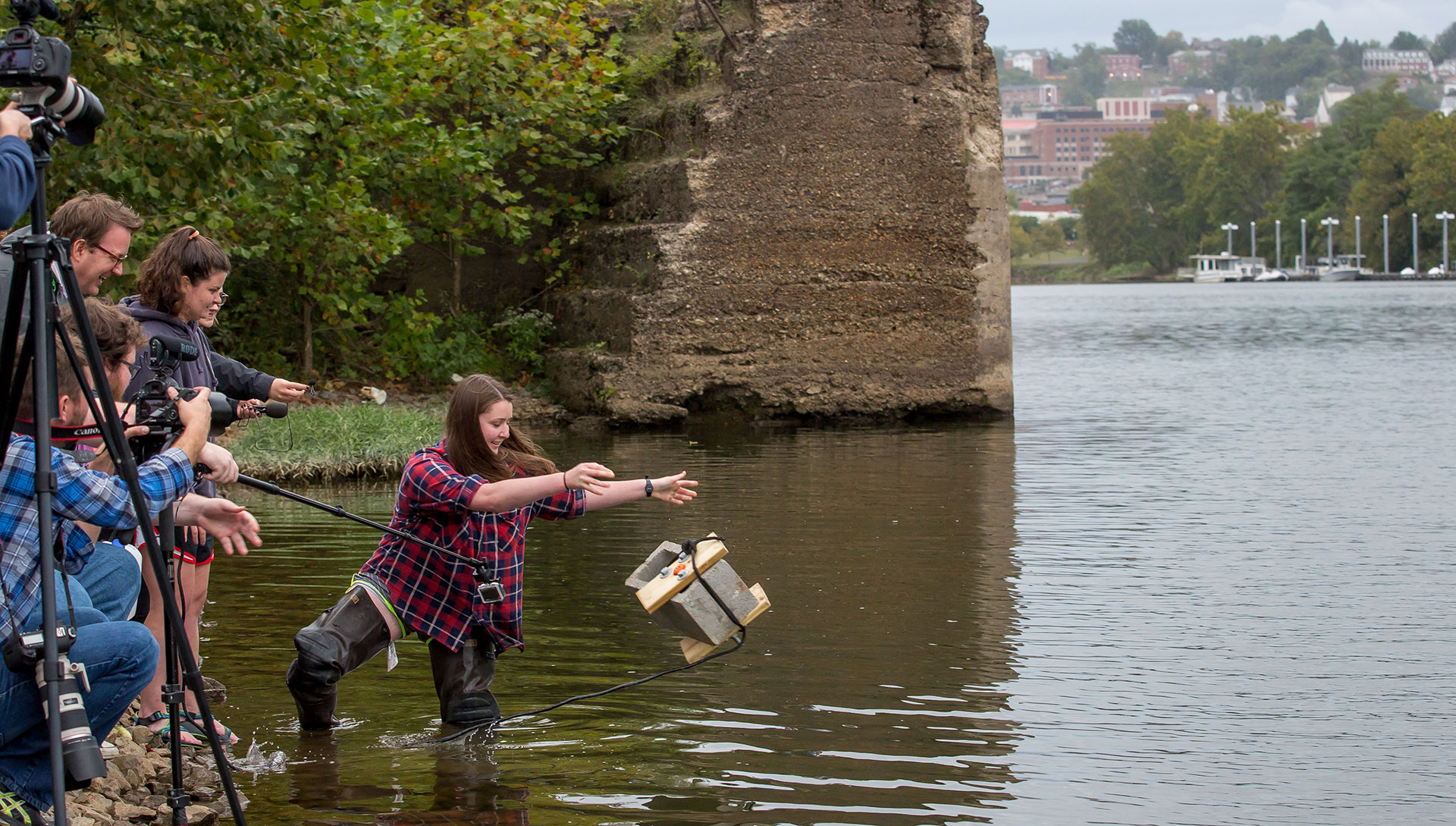
How a university sensor project could impact water quality and drive public policy
Above: West Virginia University StreamLab students launch a test water sensor in the Monongahela River across from the campus in Morgantown, W.V. Photo by David Smith/WVU Reed College of Media.
Dave Mistich is the digital editor at West Virginia Public Broadcasting. He is one of the Knight Foundation-funded Innovators in Residence at West Virginia University’s Reed College of Media.
Let’s face it: Water is one of the biggest issues in America.
Whether the story is about the quantity or the quality of water, there is huge potential for digital and data journalists to tell stories that can not only educate the public, but also (and arguably more importantly) have impact on shaping sound public policy.
Stories like the drought in California have yielded useful data reporting, particularly public radio station KPCC’s project on tracking monthly usage of water by “hydrological region.” But the station didn’t simply visualize monthly water usage. They also displayed warnings and penalties assessed by local governments, as well as usage reduction targets.

West Virginia University Reed College of Media student Elisha Wagoner looks at a circuit board during class. The class used the boards to create sensors that measured pollution levels in West Virginia waterways. Photo by David Smith.
No surprise, there are also many possibilities for using data in regards to investigating and reporting on issues surrounding water quality.
Scientists and other field researchers can collect information on contaminations—be it lead levels in children who’ve consumed the local water supply in Flint, Michigan, or the amounts of the coal-scrubbing chemical MCHM leaking into the water supply of 300,000 West Virginians back in January 2014.
But such data does little to mitigate the impacts of a contamination after the fact.
Oftentimes, scientists are creating testing procedures for contaminates on the fly, responding to a potentially threatening situation instead of being able to be out in front of them. It may take weeks (or months, sadly) for the data to be collected, the findings to be released and journalists to report on it.
Sure, some large news organizations might consider funding an investigation using costly sensors or testing kits.
But what if journalists at smaller-scale outlets and even everyday residents had the power to act as an early warning for the contamination of a water source?
(This could have real impact on getting out in front of a potential contamination or, even better, help shape public policy to prevent one in the first place.)
West Virginia University’s StreamLab project was an experiment in just that. By deploying low-cost, DIY sensors known as the Riffle, faculty and students were able to collect data on conductivity in real time.

Students in the StreamLab experimental journalism class launch water sensors in the Monongahela River. Photo by David Smith/WVU Reed College of Media.
To be clear, conductivity levels can only show that there is or isn’t something in a water source. The higher the conductivity, the more present a substance is in the water. While it doesn’t explain what—if anything—is in the water, it can certainly raise eyebrows and lead to more questions and investigation.
The StreamLab project collected data that showed some slight changes in the levels of conductivity in the Mononghela River, although not to the point where we were felt alarmed to take further action.
However, the project did prove that the Riffle sensors do work and with proper care and, attention to the deployment process, they might have the potential to serve as an early warning for contaminations. Again, such potential can empower journalists and communities to investigate water issues and help influence public policy.
In the coming months, the West Virginia University StreamLab project will be rolling out a digitally immersive experience that details some context about reporting on water quality issues. We’ll also be delving into the importance of the role a community—including journalists—can play in investigating these stories. But most importantly, we’ll be explaining how we executed our project and how others might be able to make use of the Riffles.
With little doubt, that’s something the residents of Flint and Charleston, West Virginia—and a whole slew of other communities—would have loved to have at their disposal.
Follow Dave Mistich on Twitter @davemistich.
Additional funding for the StreamLab project was provided by the Online News Association Challenge Fund for Innovation in Journalism Education, which Knight Foundation supports.
“Sensing the Environment: Investigating Community Water Stories With Sensor Journalism” is a free public workshop that will be held at the West Virginia University Reed College of Media on April 30. For more information and to register, visit kng.ht/1Sd4fjr.
Recent Content
-
Artsarticle ·
-
Artsarticle ·
-
Community Impactarticle ·


